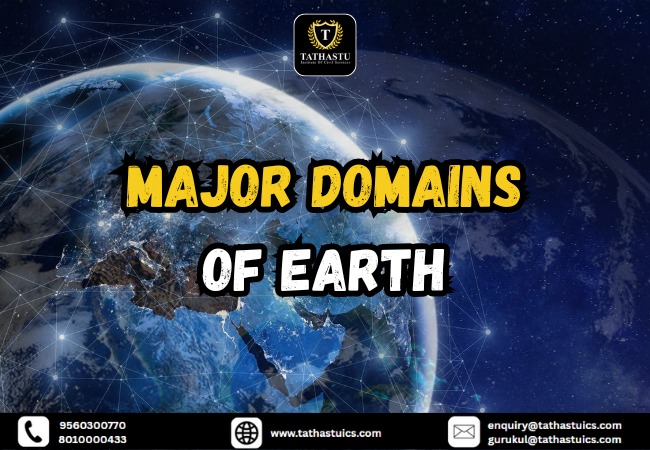Earth is the sole habitable planet in the solar system that supports life. The three fundamental components that made it possible are the combinations of land (lithosphere) with water (hydrosphere) and air (atmosphere). These three elements create a narrow zone known as the biosphere where life exists. The world’s environment functions upon these three areas, which supply necessary sustenance to all living beings.
Four Major Domains of Earth
The four major domains of the Earth are as follows:
Lithosphere
- The solid layer of earth is called as Lithosphere, which includes rock crust elements and a thin layer of soil that supports organisms.
- The lithospheric component of Earth comprises the ocean basins and continents.
- Seven extensive continents make up the surface of the Earth:
- Asia,
- Europe,
- Africa,
- North America,
- South America,
- Australia, and
- Antarctica.
- Asia is the biggest continent since it takes up one-third of all Earth’s terrestrial areas.
- The border between Asia and Europe is bounded by the Ural Mountains.
- The Equator, Tropic of Cancer and Tropic of Capricorn pass through Africa, which represents the second largest continent in the world.
- Antarctica remains permanently covered by ice and does not have any human settlements since it exists in the Southern Hemisphere.
Hydrosphere
- Every drop of water that exists on our planet constitutes the hydrosphere in the form of oceans and other forms of water such as rivers, lakes, glaciers, groundwater, and water vapor.
- More than 71% of the surface of the Earth is covered with water, hence named the “Blue Planet.”
- The five large oceans are:
- Pacific Ocean (the largest),
- Atlantic Ocean,
- Indian Ocean,
- Southern Ocean, and
- Arctic Ocean.
- Out of such a high volume of water, only a minimal portion of 2.5% is fresh water, which indicates it as a valuable and scarce resource.
Atmosphere
- Earth’s atmosphere mainly contains 78% nitrogen, while oxygen makes up 21% together with minimal portions of carbon dioxide, argon and other atmospheric gases.
- The atmosphere has five distinct layers, which form a structure:
- Troposphere,
- Stratosphere,
- Mesosphere,
- Thermosphere, and
- Exosphere.
- Carbon dioxide, although present in limited quantities in the atmosphere, serves as an essential factor for Earth’s temperature control through heat retention.
Biosphere
- All forms of life exist within the narrow area that links the lithosphere, hydrosphere and the atmosphere.
- A wide array of microscopic organisms and large mammals live together in this environment because all species are interconnected and dependent on each other.
- Biosphere equilibrium faces unbalance through various human activities such as deforestation, pollution, industrialization, climate change and the destruction of natural habitats.
Continents
- The world divides into seven continental parts which are further divided by separate water bodies.
- All major land masses exist in the Northern Hemisphere.
- The largest continent is Asia, whereas Australia represents the smallest landmass that people commonly name “Island Continent.”
- The Antarctic continent stands as the coldest and least inhabited area on Earth, having scientific research stations including Maitri and Dakshin Gangotri operated by India.
Oceans
- The Pacific Ocean stands as the deepest and largest ocean, which has the Mariana Trench, which remains the deepest point on Earth.
- The Atlantic Ocean has indented coastal features as it is well suited for developing harbors and ports.
- Indian Ocean is the only ocean which is named after a country, India which also displays a triangular shape.
- The maritime boundary defining the Southern Ocean surrounds Antarctica
- The Arctic Ocean exists within the region of the Arctic Circle.
Interactions Between the Domains of Earth
The domains of Earth create interconnected relationships that produce simultaneous effects on each other:
- Plate tectonic movements result in earthquakes along with tsunamis, which change both the Earth’s surface and its bodies of water.
- The water cycle functions as water vapor is transported from the atmospheric domain to become liquid and frozen forms in the hydrosphere domain.
- Biosphere receives essential nutrients from lithospheric soil, which enables plant life that sustains all biological creatures in the biosphere.
Conclusion
Earth exists as a habitable world because of its fundamental domains, composed of atmosphere, biosphere, hydrosphere and lithosphere, which merge together. Earth maintains its equilibrium through understanding how each sphere interacts with the others. We humans should protect it for future human generations. Practicing sustainable patterns of living with reduced environmental impact ensures success for Earth as the home for all living species.

